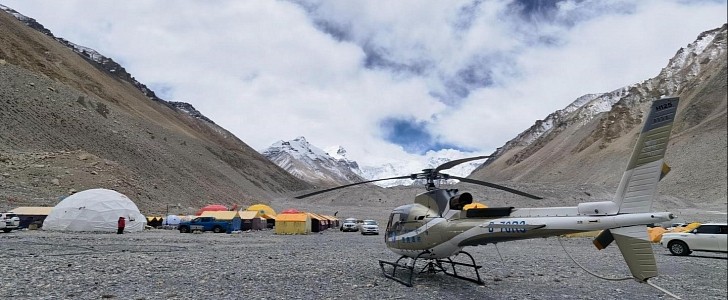Let’s take a break from summer sceneries and the heat wave and fly with the help of our imagination all the way to Mount Everest. Here, the world’s highest automatic weather station is under construction, partially thanks to the abilities of a record-breaking Airbus helicopter.
Some helicopters spend most of their lives conducting pleasant business trips from one high-class location to another, while others were meant for much greater tasks. In 2005, the H125 helicopter (formerly known as the AS350 B3 Écureuil) broke the record for the highest-altitude landing and take-off, at 29,029 feet (8,848 meters) on Mount Everest. Nobody has beat that record in 17 years.
Some of the H125 helicopters are now operating in Tibet on a regular basis. Snow Eagle Aviation, the operator of the H125 fleet, is the first high-altitude general aviation company that obtained China’s civil aviation operation permit. Since 2016, it’s been bravely functioning at these incredible altitudes and challenging conditions. Consider the fact that the take-off altitude at the Everest base camp is 17,060 feet (5,200 meters). In addition to that, the low temperature, thin air, high winds, and frequent turbulences make vertical flight even more difficult.
But none of that is standing in the way of the H125 helicopters. They are still on a pioneering path, supporting innovative projects in the area. They’re carrying research personnel and equipment from the Everest base camp to a site at 24,460 feet (7,469 meters) where the world’s highest automatic weather station (at 8,830 meters/29,000 feet) is being built.
The H125s are also carrying out afforestation flights, which have never been done in Tibet until now. These missions are planting trees so that new forests can help naturally balance CO2 levels in the atmosphere.
Powered by a Safran Arriel 2D turboshaft engine, this record-breaking rotorcraft can fly at 140 knots (161 mph/259 kph), boasting a four-hour endurance and a range of up to 340 nautical miles (391 miles/629 km).
Some of the H125 helicopters are now operating in Tibet on a regular basis. Snow Eagle Aviation, the operator of the H125 fleet, is the first high-altitude general aviation company that obtained China’s civil aviation operation permit. Since 2016, it’s been bravely functioning at these incredible altitudes and challenging conditions. Consider the fact that the take-off altitude at the Everest base camp is 17,060 feet (5,200 meters). In addition to that, the low temperature, thin air, high winds, and frequent turbulences make vertical flight even more difficult.
But none of that is standing in the way of the H125 helicopters. They are still on a pioneering path, supporting innovative projects in the area. They’re carrying research personnel and equipment from the Everest base camp to a site at 24,460 feet (7,469 meters) where the world’s highest automatic weather station (at 8,830 meters/29,000 feet) is being built.
The H125s are also carrying out afforestation flights, which have never been done in Tibet until now. These missions are planting trees so that new forests can help naturally balance CO2 levels in the atmosphere.
Powered by a Safran Arriel 2D turboshaft engine, this record-breaking rotorcraft can fly at 140 knots (161 mph/259 kph), boasting a four-hour endurance and a range of up to 340 nautical miles (391 miles/629 km).






